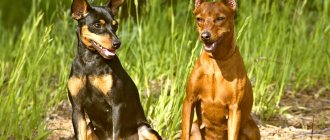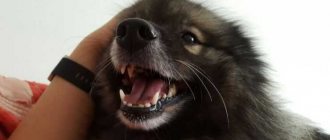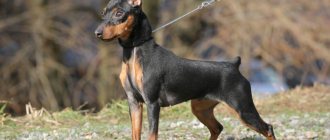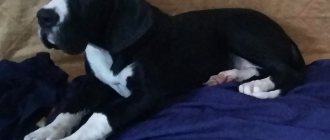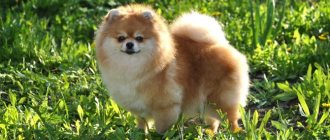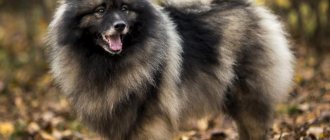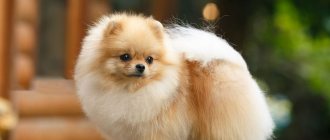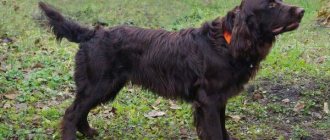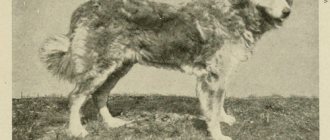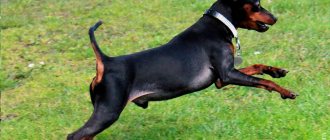History of the origin of German Pinschers
Germany is the birthplace of the breed; its origins occurred in the 18th century in the southwest of the country. The direct ancestor of the pinscher is considered to be an ancient swamp dog, which was very successful in hunting various small rodents. Pinschers are also unsurpassed hunters of small game, having inherited the hunting instinct from their ancestor.
In those distant years, pinschers were especially popular because of their devotion to their owner and endurance. These animals could get their own food and did not require special care and attention. Dogs destroyed rats in huge quantities. If necessary, they were able to scare away thieves, jealously guarding the entrusted territory.
Interesting fact: For a long time, these dogs were used to guard stagecoaches. Thanks to their endurance, pinschers followed carts and covered vast distances. They protected the cargo not only from thieves and robbery, but also from rodents.
In the second half of the 18th century, work began on the targeted breeding of purebred German Pinschers. Since 1884, the breed was already considered independent, and not a separate branch of the breed group together with schnauzers.
After the war, the popularity of German Pinschers decreased to critical levels and no one was breeding them. Only in 1958 did the restoration of the breed begin, and several new dogs were registered. Breeders have been actively working on breeding pinschers for height.
At the end of the last century, the German Pinscher was crossed with the Doberman Pinscher, which had an extremely positive effect on the breed. These animals have become excellent companions for humans, and their hunting qualities have faded into the background.
Origin of the breed and purpose
The ancestors of Pinschers are marsh dogs that lived in the southwestern region of Germany. They were used to exterminate rodents and protect livestock and farms. Thanks to their unique mobility and endurance, they accompanied stagecoaches and mail coaches. With the development of railways, the breed did not lose popularity and began to develop as an urban breed, not only in Germany, but also in Switzerland and the USA.
Since the mid-19th century, breeding work has been carried out aimed at identifying an independent breed, which was crowned with success. The first official German Pinscher standard with a description of the breed was approved in 1884.
According to the ICF classification, Pinschers are in the same group with Schnauzers (breeds such as Giant Schnauzer and Miniature Schnauzer).
Advantages and disadvantages of the breed
When you decide to buy a German Pinscher puppy, remember that the breed is distinguished by a strong, energetic and passionate character, high intelligence, and requires attention and training from an early age.
Among the strengths of the German Pinscher breed are the following characteristics:
- compact sizes, which allow them to be placed in small apartments;
- easy-care wool without undercoat;
- intelligence, self-control, devotion to the owner;
- distrust of strangers;
- vigilance, developed guard instinct;
- mobility, jumping ability, love of active games, which persists into old age.
At the same time, in order to avoid troubles, it is worth paying attention that this breed requires :
- control, attention;
- early and competent socialization of the puppy;
- active and rather long walks.
Important! Each dog has its own individuality and may not fully correspond in character to the typical traits of the breed.
German Pinscher - description of the breed
Pinschers are distinguished by the refined lines of their body, but despite this, their body is quite muscular, and their limbs are very strong. A characteristic feature of the breed are long ears, which are usually cropped, and a long, pointed muzzle.
Experts distinguish two growth varieties:
- Standard - animals reach 45-50 centimeters at the withers;
- Dwarf - the height of the dog is 25-30 centimeters.
Pinschers have a long head, flat at the top without a pronounced occipital protuberance. The muzzle is equal in length to the skull, the straight bridge of the nose is perpendicular to the head. Scissor bite, strong jaws, with well-developed masticatory muscles. Small nose. The eyes of German Pinschers are almond-shaped, small, narrow-set and have a dark brown iris. The ears are long and thin, triangular. The lips are highly pigmented and dark in color. The nose is black or dark brown depending on the coat color.
The body of the animal is quite muscular and elongated. The highest point is the withers. The back is straight and short. The body is slightly rounded, the loin is sloping. The neck is strong at the base, but quite strong. The chest is of medium width. The tail continues the croup and hangs down to the hock. It is allowed to be docked. The dog's limbs are long and thin, the thighs are strong and muscular. The paws are round in shape, tightly gathered into a ball. Pinschers have a short coat without undercoat.
Sexual dimorphism in German Pinschers is moderate. According to the approved standard, the weight of animals of this breed ranges from 15-20 kilograms.
Popular colors of German Pinschers
Smooth-haired German Pinschers can be black and tan or completely solid.
Acceptable coat color options:
- Brown;
- Murugiya;
- Red-red.
Markings are usually concentrated on the limbs, above the eyes and chest. Rarely they can be located in the genital area of the animal, on the hind legs. Today, only two types of color are officially recognized, since the work of breeders to breed German Pinschers with the “pepper and salt” color did not yield results.
All other colors are considered a fault, which significantly affect the cost of the puppies. Due to the lack of undercoat and short hair, Pinschers do not require special care. These animals are perfect for those who are allergic to wool, and also do not have enough time and skills to care for a dog. Representatives of this ancient breed always have a shiny coat, provided they have a balanced diet.
Interesting fact: Pinschers are bathed very rarely, mostly only when clearly necessary, for example when they are very dirty after a walk in bad weather. It is enough to occasionally wipe their smooth coat with a damp soft cloth.
Combing does not require a special brush, as you can get by with a hard mitten. If the pet is kept in a small apartment, then the combing procedure can be carried out 3-4 times a week. When the dog lives in a private house and if there is a sufficient number of square meters, pinschers are combed much less frequently. The animal's short hair can be easily removed from the surface of the floor and furniture.
Origin story
The German Pinscher is an old and very famous breed of dog. The ancestors were ancient swamp dogs, the result of long-term selection in the 17th century was the modern German pinscher. The standard description of the German Pinscher breed was established in 1884, changed in 1923, and additions to it are constantly made by the Federation Cynologique Internationale (FCI). The breed gained great popularity after the 60s of the last century, spreading widely throughout the world.
Character and habits of German Pinschers
German Pinschers are very intelligent, friendly and active animals, but with a balanced character. They are characterized by an excess of energy, so constant monitoring of them and timely education and training are required. These are very jealous animals that will always fight for the attention of their owner and will not allow anyone to touch their toys or bowl.
Interesting fact: The Pinscher gets along well with all family members, but will only choose an adult with a tough, balanced character as its owner. He is tolerant of other pets, but not cats and rodents.
German pinschers never attack first. In response to aggression, they respond fiercely, fearlessly defending their territory, protecting family members or property. They are wary of strangers and do not let them get close to them.
Pinschers should not be left alone with small children, as the animals are very active and can accidentally harm the child. The dog will not tolerate children's pranks and disrespectful treatment, so it is necessary to teach kids how to communicate with the pet. If a child can make friends with a pinscher and establish a relationship, then he will become a reliable friend and play companion for him for many years.
German Pinschers are cunning adventurers and manipulators, so excessive kindness when training them is unacceptable. It is necessary to teach them order and obedience from an early age, otherwise they will grow up to be completely uncontrollable animals that can be dangerous for household members. They should be socialized as early as possible.
Advantages and disadvantages
The German Pinscher is a passionate, cheerful and very active dog. Gets along very well with children of school age and older, taking an active part in their games and entertainment. The advantages include: ease of care, intelligence, devotion to the owner, vigilance, high security instincts, long-lasting physical activity.
The dog's behavior requires control; it is extremely intelligent and quick-witted . Excessive kindness and gentleness harm this breed and spoil its character. It is not recommended to leave the dog alone with small children; an active pinscher, if it becomes naughty, can harm the child, for example, by pushing him while jumping.
How do you feel about German pinschers? Do you like this dog breed?
Interesting facts about German Pinschers
The history of the German Pinscher breed goes back more than three hundred years. Their homeland is Germany, but the ancient ancestors of the breed were brought from England. Many people believe that Miniature Pinschers are descended from Doberman Pinschers, but this is wrong. It was the Doberman that was bred thanks to the miniature pinscher. A Doberman breeder under the name Doberman, having seen a miniature pinscher for the first time, decided to breed an equally strong, hardy dog with a strong-willed character, only of a larger size.
Pinschers have always been very popular in America and Europe, but dwarf specimens were brought to Russia as a trophy only after the war. For many years the breed was not in great demand among breeders, but today its popularity has grown. An interesting fact is that German pinschers are the founders of a number of dog breeds, which over time have become much more popular than their progenitor.
Pinschers are very cunning and unsurpassed manipulators. Having made a mistake, the animal tries to divert the attention of its owner and household members to something else, so that punishment for the prank does not follow. These active dogs are capable of making decisions independently and never carry out human commands without first analyzing their appropriateness.
They do not tolerate indifferent treatment, cruelty and shouting. They may be jealous of their owner towards other family members or pets. Methods for daring antics in the absence of proper education and control on the part of household members.
Comparative characteristics of the subspecies of the German Pinscher
The variety of subspecies of the breed will allow you to choose a companion dog with optimal parameters for a person.
The Doberman, having all the advantages of the breed, is distinguished by a more powerful physique and is capable of becoming a formidable bodyguard. Requires mandatory training. Suitable for a more experienced breeder who is in good physical shape due to its large size and physical strength.
The standard Pinscher will be an excellent companion for a family with children. His playful, friendly character will not let anyone feel sad, but will require strict education and control.
Tibetan Mastiff, Alaskan Malamute, Hungarian Vizsla, Dogo Argentino, White Swiss Shepherd, Irish Setter, Belgian Griffon, King Charles Spaniel, Maltipoo, Shiba Inu, Jagdterrier, Shorthaired Pointer, Norwich Terrier, Small Poodle, Pug - companion dogs , loving communication and attention.
A miniature pinscher is quite suitable as a companion for an elderly person.
Pros and cons of German Pinschers
The main breed advantages include:
- Energy and incredible activity;
- Excellent physical shape;
- Fearless character;
- Expressed instinct of guard and protector;
- Quite balanced character:
- The animal does not show excessive aggression towards strangers unless there is provocation on their part;
- Good learning ability, high level of intelligence;
- The ability to adapt to the nature of one’s character, its pace of life;
- Unpretentious, not very difficult to care for;
- Quite good health and a small number of congenital pathologies.
This breed also has its disadvantages, the extent of which depends on the quality of the pet’s upbringing.
Disadvantages of German Pinschers:
- German Pinschers are very jealous of their owners, as well as their toys, and are capable of fiercely defending them;
- These dogs are absolutely incompatible with cats and will hunt any small pets such as guinea pigs or rats;
- Pinschers are considered strong manipulators and, for this reason, the process of raising them should be taken very seriously, otherwise the pet will establish its own rules and stop obeying its owner;
- Dogs are very proud, have a strong sense of self-esteem, and can be stubborn;
- German Pinschers require regular long walks and physical activity, which can be difficult for some owners;
- Being rat catchers, many pinschers like to dig deep holes, which may not have the best effect on the appearance of the garden;
- Animals do not have an undercoat, so they do not tolerate low temperatures well and they require special dog clothing.
Before getting a German Pinscher, you should familiarize yourself with the characteristics of the breed, get advice from breeders, and talk to dogs in the kennel. This breed is suitable for both active young people and older couples, but for families with small children, pinschers will create a number of difficulties.
Advantages and disadvantages
Before you buy a puppy, you need to carefully analyze all the positive and negative aspects so that there are no problems with its maintenance in the future: Pros:
- courage and fearlessness;
- devotion to its owner;
- developed hunter instinct;
- activity;
- endurance;
- high intelligence;
- friendly attitude towards children and other pets;
- cleanliness;
- easy to care for, unpretentious in food.
The disadvantages include the following qualities:
- can only be trained by a person with a strong will;
- perseverance and desire for leadership;
- you need to walk the dog every day, it will not sit at home;
- may behave aggressively.
A dog such as a German Pinscher will get along with an active person who is looking for not just a pet, but a real companion for walks in the park or through the forest. A faithful dog can walk with you in the park for hours without showing signs of fatigue.
Breeding German Pinschers
Breeding German Pinschers is quite simple, since they have practically no problems with mating. Healthy parents give birth to healthy and hardy puppies. The main thing is to preserve the unique qualities of the breed in order to improve subsequent offspring and eliminate the existing shortcomings of the parents. Breeding parents should be used to breed the breed.
A bitch that has already given birth to healthy offspring is selected for mating. A healthy female is the key to success. Males are selected taking into account his maternal pedigree. The first mating should take place no earlier than 15 months later, that is, during the second heat, but it is better to wait until the third. Dogs are mated no more than once a year. Bitches are used for breeding until she reaches the age of 8 years. As a rule, pregnancy in Pinschers proceeds without complications.
What difficulties may arise:
- The female may partially or completely refuse to fulfill her duties as a mother;
- Childbirth can sometimes end in a caesarean section;
- Puppies remain with their mother for five months;
- When bottle-fed, babies should be fed up to 6 times a day.
German Pinschers feel good living both in an apartment and in a country house. The main condition is regular long-term walking and physical activity. Representatives of this breed do not tolerate prolonged loneliness well. If a Pinscher is left alone at home all day, he will definitely spoil or chew something. Keeping him on a leash is unacceptable, as he requires freedom of movement.
Caring for German Pinschers
Caring for these animals does not require any special skills from the owner:
- Brushing your pet weekly with a hard glove is enough;
- During shedding, dogs are brushed every day;
- Pinschers are bathed rarely or when the coat becomes dirty; more often the coat is simply wiped with a damp cloth;
- Paws should be thoroughly cleaned after each walk;
- Ear and eye hygiene is carried out every 3-5 days, but examined daily;
- The claws are trimmed with a special nail clipper as they grow;
- Teeth are cleaned with a toothbrush and toothpaste every 5-7 days.
It is necessary to regularly examine the skin and ears of your pet for the presence of parasites and remove them in a timely manner, as they can provoke the development of many dangerous diseases, including harm to the health of household members. If there is discharge from your dog's eyes or inflammatory processes, immediately contact a specialist.
Important fact: A puppy should be taught hygiene from an early age; only in this case will the pet accept the process of combing its fur and brushing its teeth calmly.
The dog's resting place and bowls should always be clean. For walks in winter and late autumn, you should purchase special clothing for dogs. Pets quite often get injured on their paw pads while walking outside, so it is important to check them regularly and lubricate them with a rich cream or oil. If there are cracks or wounds, you should immediately contact a veterinary clinic.
German Pinschers are very unpretentious and are perfect for inexperienced breeders, especially those who are allergic to wool.
Origin
Historically, dogs of this breed were distinguished for their ability to resist opponents, because “pinscher” literally means “biter” in German. Pinschers were bred in Germany; the first mention of the breed dates back to the 16th–17th centuries. Selecting dogs based on size has produced several varieties of pinschers, including the miniature pinscher. Standard pinschers originate from ancient swamp dogs that were engaged in catching small rodents. This property was passed on to German Pinschers, who were often called Rutters and were kept in stables and farms to exterminate rodents and protect the owner’s livestock and property. Pinschers had high performance and endurance, so they were often used to accompany stagecoaches and protect the property of passengers at stops. With the spread of railway transport, German Pinschers began to develop as city dogs in Germany, neighboring Switzerland and the United States. In the mid-19th century, directed selection of German Pinschers began. Until this time, pinschers and schnauzers were combined into one group: the standard German pinscher included smooth-haired and wire-haired individuals, which were often born in the same litter. Smooth-haired dogs were called pinschers, and wire-haired dogs were called schnauzers. Subsequently, German breeders determined the requirement for the Pinscher: in three generations there should have been only smooth-haired individuals. This is how the Pinschers breed was separated from the Schnauzers. At the end of the 19th century, a breed standard was approved. Pinschers served as the basis for the development of many European dog breeds: Doberman, Rottweiler, Affenpinscher, Miniature Pinscher. The German Pinscher is common in Germany; the Miniature Pinscher and Affenpinscher are the most popular breeds in the world. Currently, German Pinscher dogs belong to the hunting group, although according to the FCI classification they are included in the group of Pinschers and Schnauzers.
Diet of German Pinschers
The German dog should not be allowed to have constant access to food. Dogs are fed at certain hours, teaching them to follow a routine. Puppies are fed more often than adults. The animal must be hungry before the next meal, and its stomach must be empty, otherwise the functioning of the gastrointestinal tract will be disrupted and obesity may develop. All leftover food must be removed from the bowl. It is acceptable to use both dry food and a complete transition to natural nutrition. The main rule is not to combine both types of feeding.
The basis of natural nutrition:
- Meat, but not pork;
- Various offal;
- Porridge;
- Fermented milk products and fish.
Vitamin supplements are very important. Any smoked meats, sweets, or legumes are completely prohibited. It is better to consult a veterinarian to create a balanced diet. Pinschers do not digest pearl barley and barley well, so they are completely excluded from the menu. Pasta and any flour can provoke intestinal volvulus, as they provoke fermentation.
Dry food should be premium from trusted manufacturers. In this case, the pet owner can be sure that the body of his ward is supplied with everything necessary for normal development. With proper nutrition, you can avoid many health problems for your Pinscher. It should also be remembered that the dog needs free access to a bowl of clean drinking water at room temperature. Pinschers drink a lot, especially if they are on dry food.
Diseases and health problems
German Pinschers are considered more or less genetically healthy, but they also have hereditary diseases. The average life expectancy of representatives of this German breed is 14-17 years, some individuals live up to 18-20 years. Proper nutrition, proper care and timely vaccination, treatment of existing diseases are very important. As a rule, sick individuals are not allowed for breeding, so hereditary pathologies are rare.
What health problems may arise with your Pinscher:
- Joint dysplasia due to poor heredity or excessive stress;
- Cataract or corneal dysplasia;
- Poor blood clotting, bleeding;
- Otitis;
- Bursitis;
- Malfunctions of the gastrointestinal tract, volvulus, bloating.
Sometimes due to improper or insufficient care, pets are diagnosed with dermatitis and conjunctivitis.
Each animal receives a number of mandatory vaccinations, which can be divided into primary and secondary. Primary vaccination is carried out against mumps, leptospirosis, plague, influenza, enteritis. Rabies is vaccinated at 7 months and then annually. Vaccinations are carried out against lichen and a number of other diseases that have reduced activity.
Basic vaccines must be included in the veterinary passport. Without these vaccinations, the animal is prohibited from being transported across the border. Even if a pet is not purchased from a professional breeder, but through an advertisement in a newspaper and only as a companion who will not participate in exhibitions, vaccination is a mandatory procedure for everyone.

